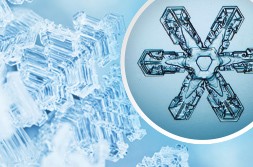The Science of Snow

By Mike Howie and Lisa Jancarik
All snow begins with a single snow crystal. This crystal forms when water vapor freezes, and as it falls it takes on a unique hexagonal shape. Eventually the crystal will collide with other snow crystals, growing larger and larger until it becomes a fluffy snowflake.
Looking at snowflakes under a microscope reveals that no two are the same, but that they do share some similar characteristics. In the 1930s, Japanese physicist Ukichiro Nakaya studied these shapes — finding stars, plates, prisms and columns — and how temperature and humidity affect their formation. He found that star-shaped crystals form at the lowest temperatures, and that branching occurs with high humidity.
Snow easily traps air, making it an excellent insulator for humans and animals alike. Animals hibernating in cold climates burrow into snow caves, trapping their body heat to stay warm all winter long. And humans pack snow into blocks to make igloos, which similarly trap heat and can be up to 70° Fahrenheit (21° Celsius) warmer than the outside air when they house a fire.
How Snow Forms
Snow is most common in the high-altitude and high-latitude areas of the world, so the closer you are to the poles or the top of a mountain the more likely you are to find snow. When temperatures reach or dip below freezing with minimal moisture in the air, snow crystals begin to form in the atmosphere and grow into snowflakes. If temperatures are warm enough on the ground, around 41° Fahrenheit (5° Celsius), the snow will land and begin to accumulate, but if it’s any warmer it will simply melt. It can never be too cold to snow, but heavy snowfalls are more common when the air on the ground is relatively warm.
Large lakes also bring large amounts of snow to an area with what has become known as the lake effect: When cold, dry air passes over a warm body of water it cools the air on the surface, picking up moisture that becomes clouds. When those clouds get large enough and move over land they produce snow, blanketing the area around the lake. This is very common along the Great Lakes in the United States.
But not all snow is natural. Ski resorts commonly use snow machines to make their own snow and extend the ski season. These machines shoot droplets of water into the outside air, which quickly freeze and fall as snow. While the machines can produce snow when there is no natural precipitation, they still need low temperatures and humidity levels to work.
Beyond just being natural or man-made, snow has many natural variations. And because it can sit on the ground for so long it exists in layers. Inevitably, some of those layers are weaker than others, and a shift in weather or any additional load on a weak layer — like a skier or fresh snowfall — can make it collapse and trigger an avalanche.
Snow and Climate
Snow reflects 80 to 90 percent of sunlight, which cools the Earth and regulates the exchange of heat between the surface of the planet and the atmosphere. It serves as a protective layer for soil and the organisms that live in it, insulating against the extremes of air temperature and locking in moisture.
Climate change, however, is melting this protection away. By impacting the amount of snowfall and the timing of the snow season, climate change is reducing the amount of snow that will cover the Earth in coming years. Europe and Asia will experience this most dramatically, but it will affect the entire world. In the United States, snowfall has been on the decline since at least 1930. The only outlier here is the Great Lakes, which have seen slightly more snowfall than previous years.
The loss of this snow is already beginning to affect the water supply in some areas. In April of 2015, California Governor Jerry Brown announced statewide water restrictions in reaction to a shrinking Sierra Nevada snowpack. Snowmelt provides as much as 75 percent of water in some areas of the U.S., and at one point it was scarce enough to leave the South Platte River in Colorado and Nebraska dry.
CLASSROOM DISCUSSION
- How much snow does your area get every year? Does it get more or less snow than it did in the past?
- What different kinds of snow have you seen, and what makes them different?
VOCABULARY
- Avalanche
- Insulate
- Lake Effect
- Water Vapor

